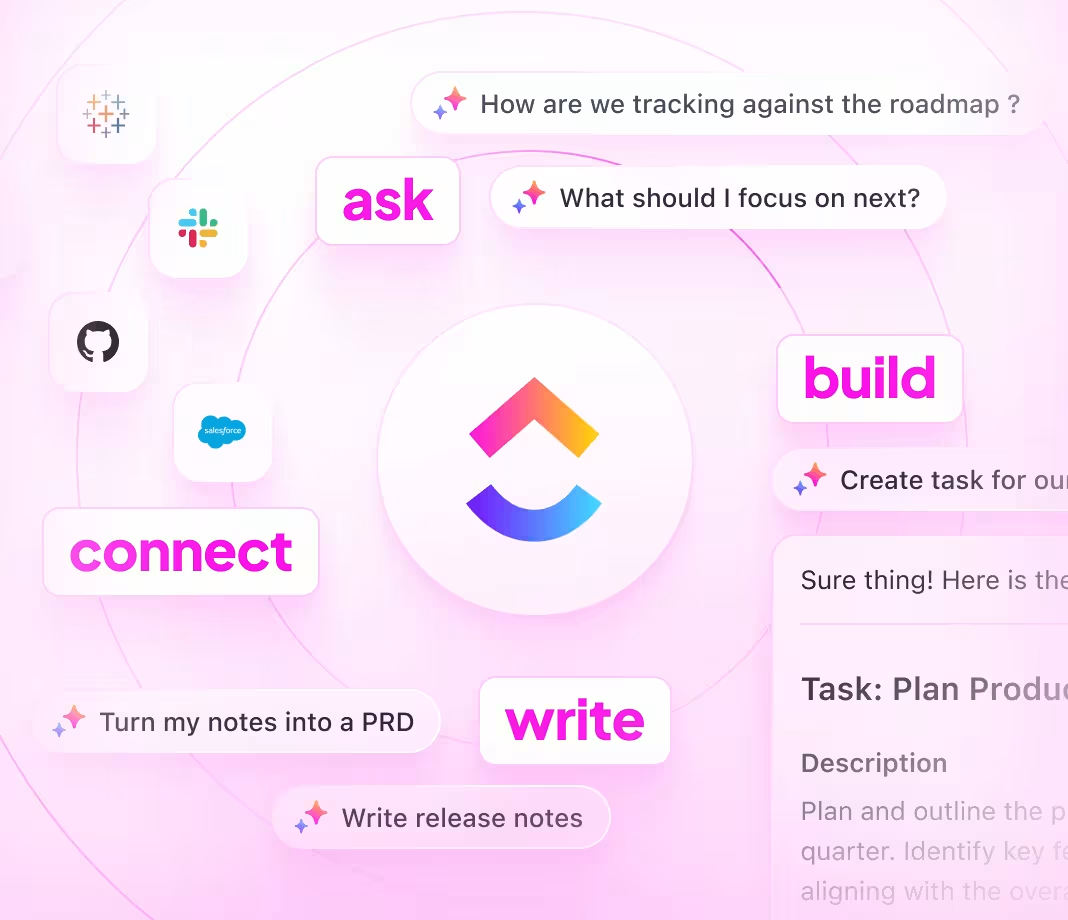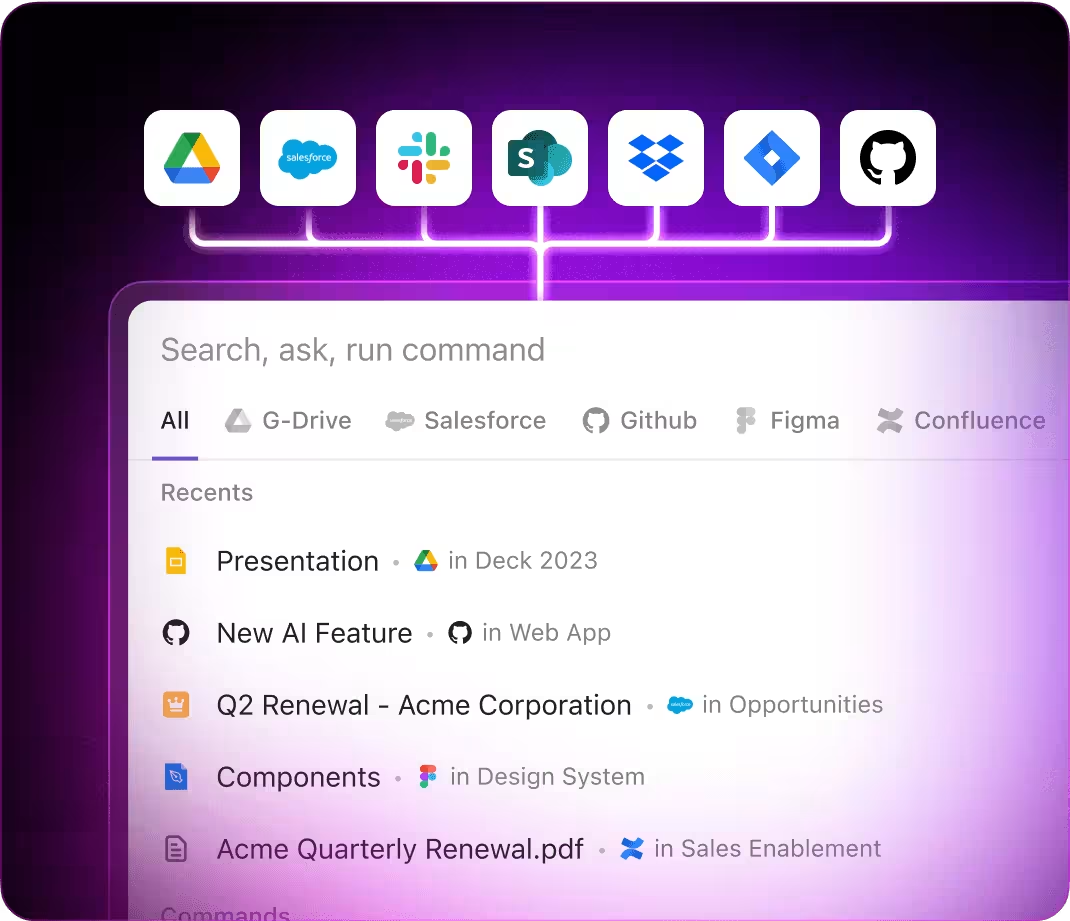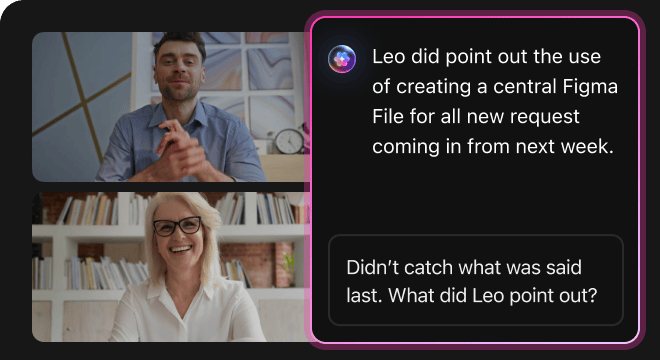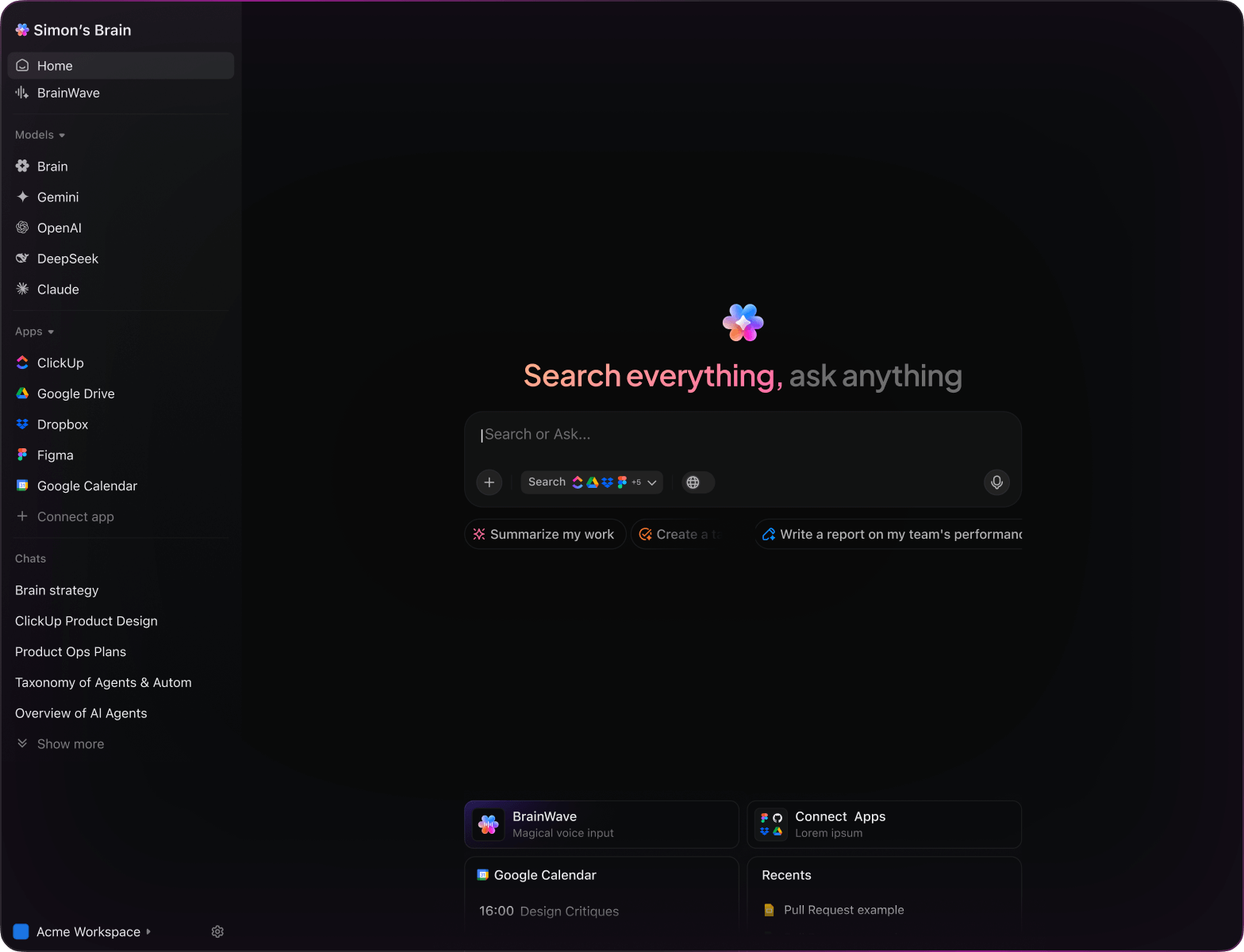AI Model Schema Mastery
Top AI Prompts for Model Schema Success
Design precise schemas, enhance your data workflows, and elevate your modeling projects effortlessly with ClickUp AI.

Trusted by the world’s leading businesses
AI in Model Schema Development
Revolutionizing Model Schema Creation with AI Prompts
Crafting precise model schemas is more than just defining data structures—it's about streamlining collaboration and accelerating development cycles.
From initial concept mapping to validation and deployment, building model schemas involves juggling numerous details, revisions, and team inputs. AI prompts are now pivotal in managing this complexity.
Teams leverage AI to:
- Quickly identify schema patterns and best practices
- Generate detailed schema drafts from brief descriptions
- Extract and summarize technical requirements effortlessly
- Transform scattered notes into organized schema components and task lists
Integrated within familiar tools like documents, diagrams, and project boards, AI in ClickUp Brain acts as a silent partner—turning fragmented ideas into clear, actionable model schema workflows.
Comparing ClickUp Brain with Conventional AI
Discover Why ClickUp Brain Stands Apart
Designed to understand your workflow deeply, ClickUp Brain lets you focus on progress instead of explanations.
Conventional AI Solutions
- Constantly toggling between apps to collect details
- Repeating your objectives with every query
- Receiving generic, irrelevant feedback
- Hunting through multiple platforms for a single document
- Interacting with AI that lacks initiative
- Manually switching among different AI engines
- Merely an added browser plugin
ClickUp Brain Advantage
- Instantly accesses your projects, notes, and team changes
- Keeps track of your past tasks and targets
- Provides insightful, context-driven guidance
- Searches seamlessly across all your resources
- Enables hands-free input with voice commands
- Automatically selects the optimal AI model: GPT, Claude, Gemini
- Dedicated desktop app for Mac & Windows optimized for performance
Model Schema AI Prompts
15 Essential AI Prompts for Model Schema Development
Accelerate your model schema workflows—design, validation, and optimization simplified.

Identify 5 structural design patterns for a customer profile schema, inspired by the ‘Q2 Data Model Review’ doc.
ClickUp Brain Behavior: Analyzes linked documents to extract schema patterns and suggests design directions based on documented examples.

What normalization techniques are prevalent in modern e-commerce schemas under 3NF?
ClickUp Brain Behavior: Aggregates insights from internal schema design docs; Brain Max can supplement with public standards if available.

Generate a detailed schema spec for a product catalog supporting dynamic attributes, referencing ‘Catalog Schema v4’ and prior design notes.
ClickUp Brain Behavior: Extracts relevant schema elements and compiles a structured specification document.

Summarize indexing benchmarks from ‘Indexing Techniques Q3’ doc comparing relational and NoSQL database schemas.
ClickUp Brain Behavior: Pulls tabular and descriptive data to produce a concise comparison report.

Identify commonly used data types for time-series entries in IoT device schemas, referencing R&D notes and standards docs.
ClickUp Brain Behavior: Scans internal documents to list frequent data types and their performance considerations.

From the ‘Schema Validation Guidelines’ doc, create a DVP&R-style checklist for schema compliance verification.
ClickUp Brain Behavior: Extracts validation criteria and formats them into a structured checklist within a task or document.

Highlight 3 key schema design trends in microservices architectures from recent research and technical review docs.
ClickUp Brain Behavior: Identifies recurring themes and insights from linked research materials.

Summarize main preferences for API schema formats and conventions from the ‘Developer Survey 2024’ doc.
ClickUp Brain Behavior: Analyzes survey data to extract common design preferences and feedback patterns.

Write clear, user-friendly error messages for schema validation failures using the tone guide in ‘StyleGuide.pdf’.
ClickUp Brain Behavior: References tone and style guidelines to generate varied message suggestions.

Outline key changes in 2025 data privacy laws and their implications for schema structures, based on internal compliance docs.
ClickUp Brain Behavior: Synthesizes regulatory documents to highlight schema design impacts; Brain Max can add public updates if available.

Create placement and versioning guidelines for schema evolution, referencing company standards and industry best practices.
ClickUp Brain Behavior: Extracts rules and recommendations from internal docs to form a comprehensive guideline checklist.

From US Performance Testing standards and internal benchmarks, create a checklist for schema load and query performance tests.
ClickUp Brain Behavior: Identifies test requirements and organizes them into tasks grouped by test type and severity.

Summarize differences in schema flexibility and extensibility among PostgreSQL, MongoDB, and Cassandra using competitive analysis docs.
ClickUp Brain Behavior: Condenses documented comparisons into an easy-to-read summary or table.

What schema design patterns have gained traction in event-driven architectures since 2023?
ClickUp Brain Behavior: Synthesizes trends from internal research, whitepapers, and uploaded reports.

Summarize frequent user-reported challenges in schema management from feedback folders, focusing on UI, validation, and collaboration.
ClickUp Brain Behavior: Extracts and prioritizes issues from surveys, support tickets, and feedback notes.
Accelerate Model Schema Creation with ClickUp Brain
Cut down revisions, unify your team, and produce superior model designs through AI-driven workflows.






Bridging AI and Workflow: ClickUp Brain Empowers Model Schema
Discover How ChatGPT, Gemini, and Perplexity Tackle Model Schema Challenges
ChatGPT Model Schema Prompts
- Outline a 5-step schema design plan focusing on data integrity and scalability.
- Compose user documentation for a new schema version highlighting flexibility and validation.
- Generate 3 schema normalization approaches for a customer database and explain their benefits.
- Draft a workflow for integrating schema changes into existing applications with minimal downtime.
- Compare last 3 schema iterations and summarize key improvements for future updates.
Gemini Model Schema Prompts
- Propose 3 visualization layouts for schema relationships based on user feedback.
- List innovative schema indexing strategies to enhance query performance.
- Create a mood board description for a schema design interface emphasizing clarity and usability.
- Suggest entity-relationship configurations for a multi-tenant database and rank them by efficiency.
- Develop a comparison chart for three schema validation tools focusing on features, speed, and compatibility.
Perplexity Model Schema Prompts
- Identify 5 emerging schema design patterns and evaluate their applicability.
- Provide a comparison of serialization formats for model schemas, highlighting speed and compatibility.
- Summarize industry trends in schema evolution and their impact on development cycles.
- Generate a list of 5 schema versioning strategies and assess their pros and cons.
- Review past schema refactoring cases and extract top 3 best practices for maintainability.
ClickUp Brain Model Schema Prompts
- Transform this schema review discussion into prioritized development tasks with clear deadlines.
- Condense meeting notes on schema optimization and assign follow-up actions to team members.
- Examine annotated schema diagrams and create a checklist for validation and testing.
- Generate a task list from cross-department feedback on schema updates, including urgency levels.
- Summarize user feedback on schema usability and produce actionable design and implementation tasks in ClickUp.
Why Choose ClickUp
Transform Initial Thoughts into Polished Models
- Convert scattered notes into detailed model blueprints swiftly.
- Generate innovative concepts by leveraging previous schema data.
- Build adaptable templates that accelerate your entire workflow.
Brain Max Boost: Effortlessly explore historical schemas, reviews, and documentation to fuel your upcoming model designs.

Why Choose ClickUp
Accelerate Model Schema Collaboration
- Break down intricate model details into straightforward tasks.
- Transform schema annotations into actionable assignments.
- Automatically produce detailed summaries and progress reports without extra effort.
Brain Max Boost: Instantly access historical schema versions, component analyses, or design rationale across all projects.

AI Advantages
Elevate Every Phase of Model Schema Creation with AI Prompts
AI prompts accelerate innovation and empower more precise, adaptable model schemas.
Instantly Craft Robust Schema Designs
Schema architects explore diverse structures swiftly, enhance design accuracy, and prevent analysis stalls.
Enhance Schema Decision-Making
Make informed choices, minimize errors, and develop models that meet both user needs and compliance standards.
Identify Flaws Early to Save Resources
Detects potential schema issues upfront, boosts reliability, and accelerates deployment timelines.
Align Teams with Unified Schema Vision
Improves cross-functional communication, reduces misunderstandings, and expedites consensus among developers and analysts.
Drive Schema Innovation Beyond Limits
Inspires creative modeling approaches, fosters advanced schema concepts, and keeps your projects future-ready.
Integrated AI Support Within ClickUp Workflows
Transforms AI insights into actionable tasks, ensuring model schema projects advance efficiently.
Speed Up Your Model Schema Workflow
Cut down mistakes, simplify collaboration, and generate insightful results using AI-powered support.





